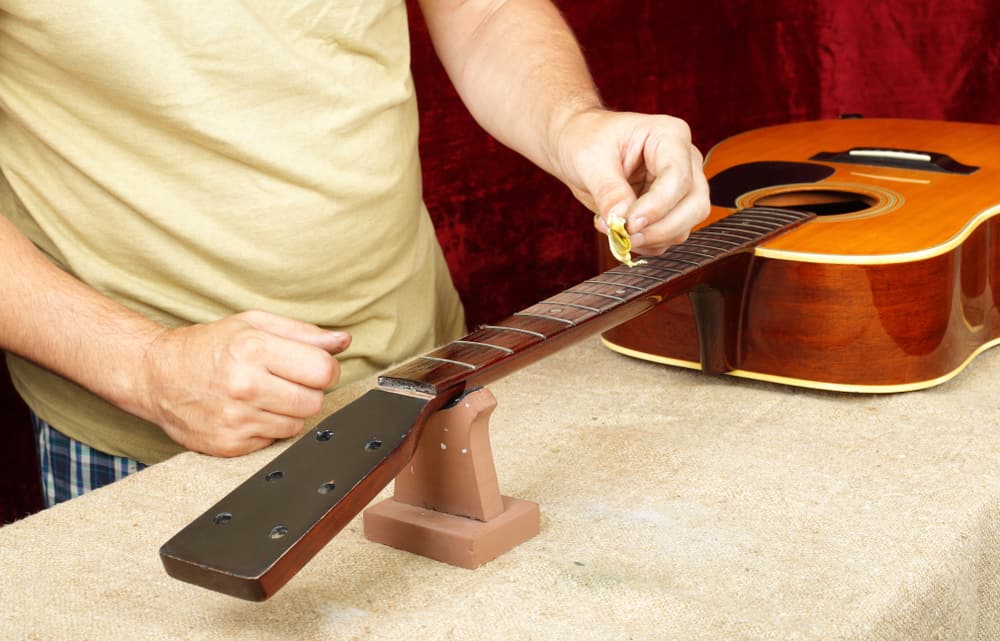The guitar is a very versatile instrument, but it can also be a very temperamental instrument. Not everyone realizes that guitars require significant maintenance and can be severely negatively affected by seemingly insignificant factors such as humidity and moisture. Guitars can be easily damaged by humidity, which leaves some guitarists wondering how long it takes for humidity-related issues to occur?
Guitars that are more susceptible to humidity, such as acoustic guitars or guitars with a damaged finish, may be affected by humidity in as little as a few days. Some electric guitars and guitars that are well-sealed may only experience serious issues after being placed in humid conditions for as long as a year.
Most guitars are made mostly from wood, which is heavily affected by humidity, however, other components of a guitar may be sensitive to climate as well. If you live in an area or environment with high humidity, or if you plan to visit such an area with your instrument, it is important to understand the damage that humidity may cause, how long it takes for serious damage to occur, and what to do if your guitar is negatively impacted by humidity.
How Does Humidity Negatively Affect A Guitar?
Guitars are very temperamental instruments, as are all string instruments. Every new iteration of the guitar is designed with features that are meant to try and mitigate how unstable the guitar can be, but there is no getting around the fact that the materials that guitars are made from are susceptible to changes in humidity.
The guitar is a string instrument that is made primarily of wood. If you have ever left some firewood out overnight or during a rainstorm, you will know that wood is easily affected by humidity as it absorbs moisture very readily.
However, most guitars are treated and sealed with varnishes, sealants, and paints to prevent the wood from being exposed to high levels of humidity and moisture, so how does high humidity negatively affect a guitar at all?
The truth is that no matter how well-sealed a guitar is, the wood will still be affected by humidity over time. The effects are not as drastic or noticeable as they may be without any moisture defenses, but as a guitar is exposed to high humidity, there are aspects of it that will be negatively affected.
Humidity negatively affects the guitar by warping the wood of the instrument. This leads to severe tuning instability, a change in the setup of the instrument that can affect intonation, action, and the feel of the guitar, and as the wood expands due to humidity, the forced changes to the hardware, as a result, may cause permanent damage to the instrument.
For this reason, it is critical to take measures against humidity-related damage if you live in an area with above-average humidity or if you will be visiting such an area with your instrument.
How Long Does It Take For Humidity To Affect A Guitar?
The negative effects of humidity on a guitar can happen quickly, or they can occur over time. There are several critical factors that determine how long humidity takes to cause damage to a guitar, and understanding them is vital.
A guitar will be quickly affected by the humidity if the guitar is untreated, if the finish on the wood of the instrument has been damaged or rubbed off, or if the wood is exposed to the air.
Acoustic guitars are far more sensitive to humidity than electric guitars, and the playability of acoustic guitars can be negatively affected by humidity in short periods of time.
The humidity level also plays a role here. If the relative humidity in the environment is very high, the guitar will be affected more quickly than if the humidity is at a lower level.
Guitars that are susceptible to damage from humidity may experience negative effects within a few days of being exposed to high levels of moisture in the air.
Electric guitars are less affected by humidity than acoustic guitars, as electric guitars’ wooden bodies and necks are usually made from thicker, denser and less fragile pieces of wood than acoustic guitars.
Guitars that are well-maintained and well-kept will be less affected by humidity, and guitars that are made with very good sealants will experience fewer negative effects as well.
A guitar that is less susceptible to high humidity may take up to a year to fully realize the extent of the negative effects of humidity, so long as the guitar is well looked after in that time.
How To Prevent Humidity-Related Issues

If you live in a particular area with regular high levels of humidity, or if you are visiting an area that does, it is important to be sure that you take some basic steps to ensure that your guitar is as well-protected as possible from this type of damage, as it can severely hurt your instrument.
The best way to ensure that your guitar is not significantly damaged or tarnished by humidity is to simply avoid exposure to too much humidity. Unfortunately, this is not always possible, so the best alternative is to ensure that the guitar’s sealant is kept in good condition. The sealant on the finish of a guitar is the only way to prevent the wood from absorbing too much moisture.
Another good practice is to keep your guitar in a hard-shell case with some form of a dehumidifier in the case along with the instrument. There are dehumidifying devices that work to actively remove moisture from the air within a guitar case, but simple packets of silica gel thrown into the case will work well too. The Cahaya guitar bag is one of my favorite guitar storage bags. It is inexpensive and waterproof!
- Premium guitar case compatible with 40/41/42-in guitars, Length: 42.9”, Neck width: 5.5”, Body thickness: 4.96”
- 0.31-in thick sponge padding, larger and thicker-padded than previous yellow-colored model
- Two exterior pouches: a large front pocket for sheet music/documents and an extra neck pocket for accessories (pedals, adapters, cables, tuners, etc.)
- Water resistent oxford cloth exterior, strong two-way metal zippers, non-slip silicone handle, firmly-stitched.
- There is a loop handle on the back of the guitar bag, which can be hung on the wall when not in use.
The trouble with using silica gel packets is that they must be replaced regularly, or they will stop absorbing moisture, but they are very cheap to buy, so this should not be too much of an obstacle.
If you do use some form of dehumidifier within your guitar case, it is important not to over-dehumidify your guitar. Just as too much humidity may be bad for a guitar, too little humidity can be detrimental as well. Always be careful to maintain a relative air humidity in the environment that your guitar is stored in of around 45-55%.
Conclusion
It is important to remember that guitars are mostly made from wood, and this material is very susceptible to humidity. A guitar may be damaged by humidity in as little as a few days, or it may take up to a year of exposure to high humidity to notice any issues, but humidity will always eventually affect a guitar in some way.
Taking careful steps to prevent these issues is the best way to keep your guitar playing well in high humidity areas, and it should become part of your regular guitar maintenance routine.
References
https://www.taylorguitars.com/support/maintenance/symptoms-wet-guitar

